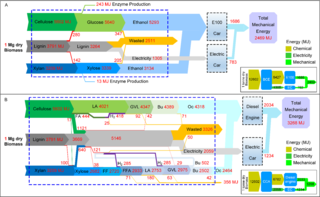Advanced Biofuels of the Future: Atom-economical or energy-economical?

Fuel quality and energy requirements, in addition to conversion carbon efficiency, are key factors in biofuel strategy development.
The Science
Current research policies identify atom-economical biofuel production pathways as the most promising. Two representative strategies: a biochemical conversion to ethanol with a higher technology readiness level (TRL) and a catalytic conversion to alkenes based on ƴ-valerolactone biomass deconstruction and catalytic upgrading, with a lower TRL are presented and compared in terms of carbon yield, heat and biorefinery power requirements, and fuel quality.
The Impact
This holistic biomass-to-wheels analysis showed that, contrary to conventional wisdom, seeking atom-economical biomass-to-fuel strategies may not necessarily be the optimal objective towards the development of the next generation biofuels. In addition to carbon yield, the study identified the energy requirements of the process and the resulting biofuel type and quality to be key factors that should be considered simultaneously in the selection of alternative biofuels and development of new biofuel strategies.
Summary
Researchers in the Great Lakes Bioenergy Research Center did a high-level carbon and energy analysis of two idealized representative biomass-to-fuel strategies to identify critical trade-offs between the selection of a target biofuel and the development of new conversion strategies. The strategies analyzed were: (1) biochemical conversion to ethanol (BCE) based on the NREL method, and (2) a catalytic conversion to alkenes (CCA) based on ƴ-valerolactone (GVL) biomass deconstruction and catalytic upgrading. They studied the impact of process energy requirements and electricity production, as well as the impact of the fuel quality, by extending the boundary of the modeling study to include the end-use of the produced fuel and electricity in the transportation sector.
When comparing mass, atom, and carbon balance for the two strategies, results showed 65% and 53% biomass-to-fuel carbon efficiency for the BCE and CCA, respectively, which makes BCE a more atom-economical strategy. However, the BCE strategy is 17% less energy efficient than CCA, due to the role of fuel quality and engine efficiency. Furthermore, if the infrastructure for widespread adoption of electric cars were available, the advantage of the CCA strategy (in terms of the resulting mechanical energy from both liquid fuel and electricity) would be even bigger. Their analysis showed that, contrary to conventional wisdom, seeking atom-economical biomass-to-fuel strategies may not necessarily be the optimal objective towards the development of the next generation biofuels. They showed that a more energy-efficient strategy leading to higher quality biofuel can be better than a strategy that is more atom-economical. Results showed that there are three major drivers affecting the overall efficiency of a biofuel strategy: (1) carbon yield, (2) process energy requirements, and (3) biofuel type and quality, which determine the engine efficiency and thus fossil fuel displacement. These three drivers should be considered simultaneously towards the selection of alternative biofuels and development of new biofuel strategies.
Contacts (BER PM)
N. Kent Peters
kent.peters@science.doe.gov, 301-903-5549
(PI Contact)
Christos Maravelias
christos.maravelias@wisc.edu
Funding
U.S. Department of Energy, Office of Science, Office of Biological and Environmental Research under Award Number(s) DE-SC0018409.
Publications
Fashati, P. and Maravelias, C.T. “Advanced Biofuels of the Future: Atom-Economical or Energy-Economical?” Joule DOI: 10.1016/j.joule.2018.09.007